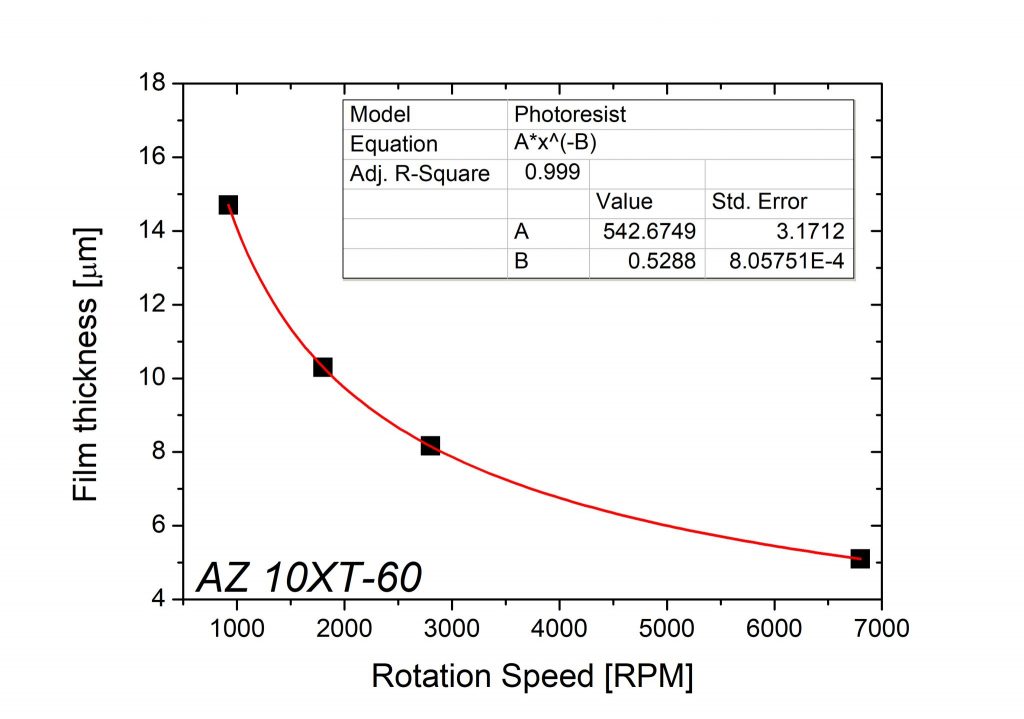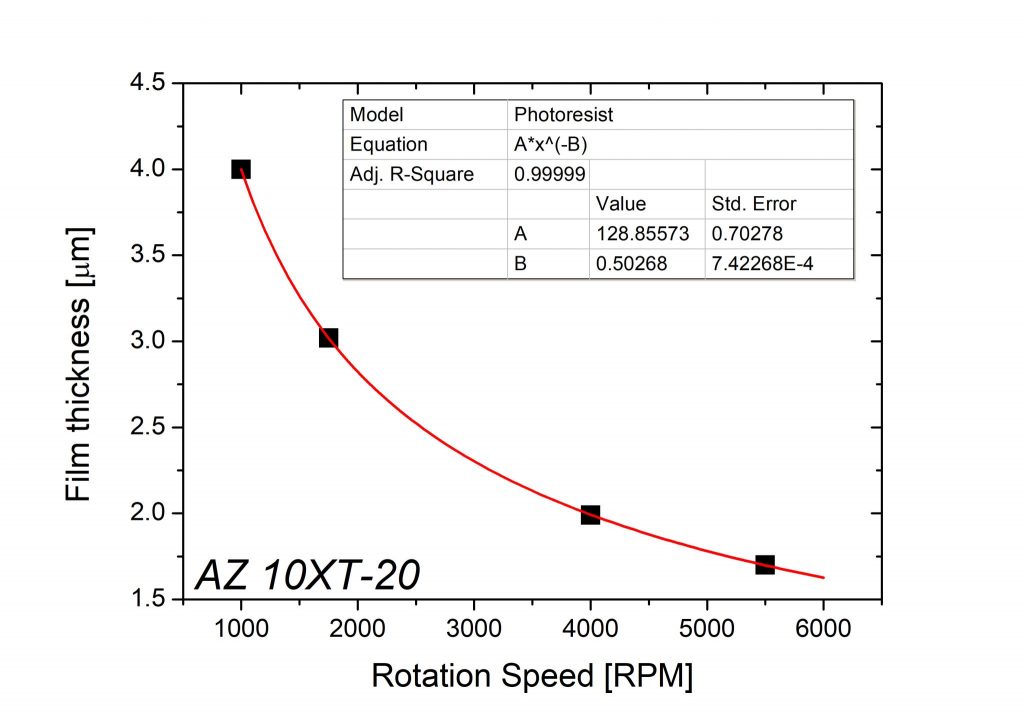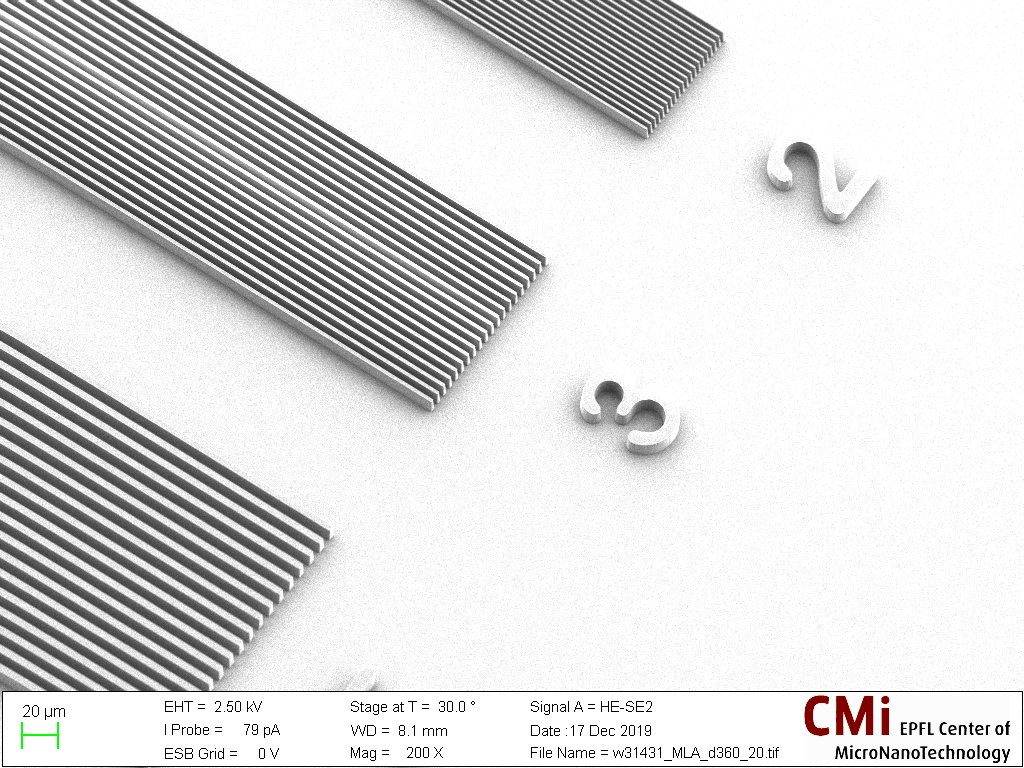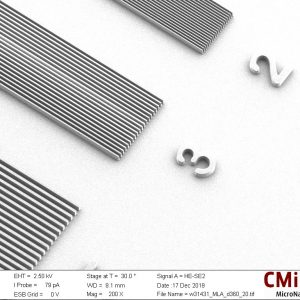! Cleanroom humidity warning !
Control of the relative humidity (RH) in photolithography zones is extremely critical. Stable and reproducible photolithography is expected within 38% to 48% RH range.
- In case of low RH (< 38%), the resist sensitivity and development rate decreases. It is then recommended to increase the exposure dose to compensate.
- In case of high RH (> 48%), the resist adhesion decreases. It is then recommended to do an additional bake (>10 minutes @ 150°C) before loading the wafers in the HMDS or coating equipment.
Wafer surface preparation
Usually adhesion of photoresist on inorganic materials is poor resulting in losses of fine structures after development. To solve the issue, silicon wafers are generally treated using the HMDS vapor prime treatment before spincoating the photoresist. Details about the HMDS process and control can be found here: link
Assuming wafers with a clean surface free of organic contamination, the best adhesion will be obtained with the surface preparation recommended in the table:
| Surface material (larger area) | Vapor HMDS | Plasma O2 | Thermal dehydratation |
|---|---|---|---|
| Si | √√ | √ | √ |
| SiO2, fused silica, SiN, Si3N4 | √√ | √ | √ |
| Float glass, pyrex | √ | √√ | √ |
| Metals: Al, Au, Pt, Ti | … | √ | √√ |
| Metals: Ag, Cu, Cr, Fe | … | X | √√ |
| III/V semiconductors (GaN, GaAs) | … | X | √√ |
Legend: √√ Strongly recommended / √ Alternative process / … Not effective / X May affect or destroy underlaying material
Spincoating
The AZ 10XT-20 and 10XT-60 spincurves are shown below, as well as process details for both automatic and manual coating.
Available thicknesses: 2 um / 3 um / 4 um / 5.5 um / 8 um / 15 um
Coating:
| PR thickness [μm] | PR | Dispense method | Spin speed [RPM] | Spin duration [sec] | Notes |
|---|---|---|---|---|---|
| 2 | 10XT-20 | dynamic, 1650RPM | 6000 | 40 | |
| 3 | 10XT-20 | dynamic, 1650RPM | 1650 | 40 | |
| 4 | 10XT-20 | dynamic, 1050RPM | 1050 | 40 | postbake BSR/EBR |
| 5.5 | 10XT-60 | spiral | 6000 | 40 | |
| 8 | 10XT-60 | spiral | 2600 | 40 | |
| 15 | 10XT-60 | spiral | 920 | 40 | postbake BSR/EBR |
Softbake:
| PR thickness [μm] | Bake method | Temperature [°C] | Bake duration [sec] |
|---|---|---|---|
| 2 | minimum proximity | 110 | 120 |
| 3 | minimum proximity | 110 | 180 |
| 4 | minimum proximity | 110 | 210 |
| 5.5 | minimum proximity | 115 | 240 |
| 8 | minimum proximity | 115 | 240 |
| 15 | minimum proximity | 115 | 360 |
Available sequence options:
- HMDS / EC (edge clean)
- Dehydrate / EC
- No treatment / EC
- HMDS / EBR (edge bead removal)
- Dehydrate / EBR
- No treatment / EBR
- Find the spin-coating speed “XXXX” [RPM] matching your target thickness from the AZ 10XT-60 spincurve.
- When coating on wafers, use the HV_”XXXX” recipe, which includes a 500 RPM spreading step and 100 seconds of main coating step.
- When coating on small chips, use the CHIP_”XXXX” recipe, which includes 40 seconds of main coating step and a short acceleration at the end to reduce edge bead effects.
- Softbake temperature: 105°C
- Softbake time: 90” + 20”/um
Exposure
Important note on rehdratation of AZ 10XT-60:
Optimal and stable lithography results cannot be obtained without a minimum rehydratation delay which allows water molecules to diffuse homogenoueously in the freshly coated layer. Without sufficient water content, chemical reactions induced by photons cannot be completed. Please respect the minimum rehydratation time given in the following table (for normal cleanroom relative humidity conditions (≥40 RH)).
| PR thickness [µm] | Minimum rehydratation time [hour:min] | Remark |
|---|---|---|
| 5 | 00:07 | |
| 8 | 00:12 | |
| 10 | 00:25 | |
| 15 | 00:40 | |
| 20 | 00:50 |
Note: Diffusion time is largely dependant of relative humidity. Dry air with relative humidity smaller by -2.0 RH double the rehydratation time.
The following table lists the recommend dose “to clear” for the AZ 10XT family coated on silicon wafers. It is recommended to perform a contrast curve / exposure matrix calibration for wafers other than silicon.
| Illumination: | Broadband* | i-line (355-365 nm) | h-line (405 nm) |
|---|---|---|---|
| Equipment: | MABA6, MA6 Gen3 (no filter) | VPG 200, MA6 Gen3 (filter), MJB4 | MLA 150 |
| PR thickness [µm] | Dose [mJ/cm2]+ | Dose [mJ/cm2]++ | Dose [mJ/cm2]+++ |
| 2 | 190 | 175 | Refer to Resist Tables |
| 3 | 240 | 220 | |
| 4 | 300 | 270 | |
| 5.5 | 360 | 330 | |
| 8 | 460 | 420 | |
| 15 | 660 | 580 |
* Mercury Lamp, Mask Aligner with UV400 configuration & no filter / + Based on intensity readings from Süss optometer broadband CCD / ++ Based on intensity readings from Süss optometer i-line CCD / +++ Based on MLA150 internal dose measurements
Development
The recommended developer for AZ 10XT is AZ 400K (diluted in water 1:3.5), an inorganic solution based upon KOH. Development with AZ 400K will result in a sharper edge profile.
Development sequences for the AZ 10XT resist family on the ACS200 are detailed below:
Development:
| PR thickness [μm] | Developer | Dev. method | Cycle time [sec] | N° of cycles |
|---|---|---|---|---|
| 2 | AZ 400K:H2O 1:3.5 | puddle | 60 | 3 |
| 3 | AZ 400K:H2O 1:3.5 | initial spray (12sec) + puddle cycles | 50 | 3 |
| 4 | AZ 400K:H2O 1:3.5 | initial spray (12sec) + puddle cycles | 60 | 3 |
| 5.5 | AZ 400K:H2O 1:3.5 | combined spray + puddle cycles | 66 | 4 |
| 8 | AZ 400K:H2O 1:3.5 | combined spray + puddle cycles | 66 | 5 |
| 15 | AZ 400K:H2O 1:3.5 | combined spray + puddle cycles | 66 | 8 |
In case of non-complete PR dissolution with the standard development duration, please use any of the D4+(X)-400K sequences to add some development time.
- Recommended developer: AZ 400K diluted 1 to 3.5 DI
- Development time: 45″/um
- Rinse: H2O 1min
IMPORTANT:
After development, it is mandatory for wafers to go through an additional rinsing step with DI water to avoid backside contamination and damage on equipments (chuck in etcher) in further processing steps. The water baths of the following wet benches can be used free of charge (5 min. billing delay after login):
- Z01 – Plade “Solvent” wet bench
- Z02 – UFT “Resist” wet bench



